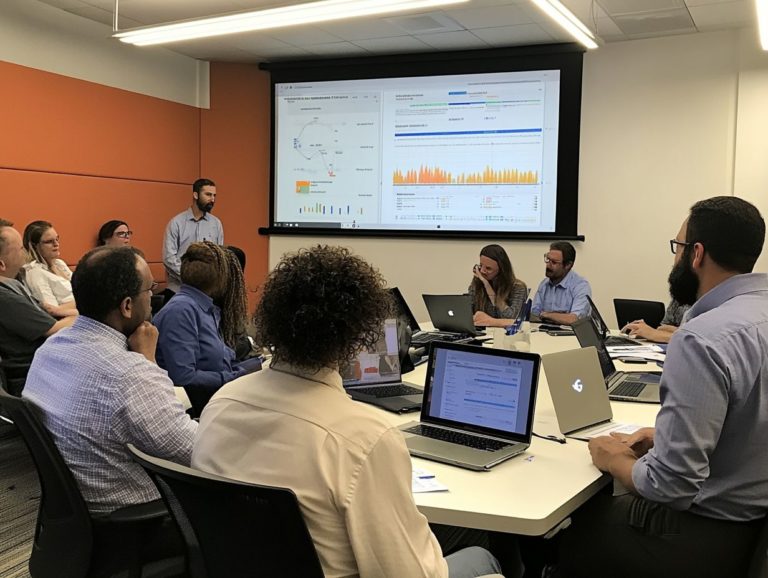how regulations impact vulnerability assessment practices
In a world increasingly influenced by environmental changes and industry demands, understanding vulnerability assessments has never been more essential.
These evaluations go beyond identifying potential risks; they navigate the complex web of regulations governing assessment practices. Environmental laws and industry-specific guidelines are integral to ensuring thorough and responsible evaluations.
This article will define vulnerability assessments, explore the regulatory landscape, and address challenges and best practices for conducting these critical evaluations effectively.
Let s dive into the crucial relationship between regulations and vulnerability assessments, paving the way for informed decision-making and strategic planning.
Contents
- Key Takeaways:
- Understanding Vulnerability Assessments
- Importance of Regulations in Vulnerability Assessments
- Types of Regulations Impacting Vulnerability Assessments
- Challenges and Limitations of Regulations in Vulnerability Assessments
- Best Practices for Conducting Vulnerability Assessments
- Frequently Asked Questions
- What are vulnerability assessment practices?
- How do regulations impact vulnerability assessment practices?
- What are some examples of regulations that impact vulnerability assessment practices?
- How do regulations help improve vulnerability assessment practices?
- What are the consequences of not complying with regulations for vulnerability assessment practices?
- Can organizations customize their vulnerability assessment practices to comply with regulations?
Key Takeaways:

- Understand the role of regulations in vulnerability assessments.
- Recognize that environmental and industry-specific regulations are key factors influencing these assessments.
- Incorporate regulations into protocols for effective vulnerability assessments.
- Collaborate with regulatory agencies to enhance your assessment efforts.
Understanding Vulnerability Assessments
Understanding vulnerability assessments is essential for organizations wanting to improve their security against cyber threats. This process involves identifying security weaknesses, evaluating risks, and ensuring compliance with standards to mitigate data breaches.
These assessments help you understand your threat landscape and prioritize your remediation efforts with precision.
Definition and Purpose
A vulnerability assessment is a systematic approach to identifying and prioritizing security vulnerabilities within your organization’s IT infrastructure.
By uncovering weak points, these assessments enable you to tackle immediate threats while enhancing your overall security posture. This proactive strategy lays a foundation for risk evaluation and management, allowing your team to implement tailored controls fitting your unique environment.
In an increasingly complex digital landscape, conducting regular vulnerability assessments is vital for adapting to emerging threats and ensuring compliance with industry standards.
The insights gained from these assessments serve as a roadmap for strategic decision-making, fostering a culture of continuous improvement in your cybersecurity practices.
Importance of Regulations in Vulnerability Assessments
Regulations are pivotal in shaping your vulnerability assessment practices. They ensure compliance while maintaining a strong security posture against the evolving landscape of cyber threats, especially when learning how to leverage vulnerability assessments for compliance.
By aligning with these regulations, you can effectively fortify your organization against potential vulnerabilities.
How Regulations Influence Vulnerability Assessment Practices
Regulatory standards shape the methodologies and frameworks you adopt in your vulnerability assessment practices. Regulations like the General Data Protection Regulation (GDPR) and the Payment Card Industry Data Security Standard (PCI DSS) set explicit expectations for organizations on identifying and managing security risks.
Following these guidelines minimizes your exposure to potential breaches and elevates your overall security posture. Compliance isn t just ticking boxes; it compels you to implement effective strategies that align with sound risk management principles.
It s essential to continuously refine your vulnerability assessments to align with evolving standards, ensuring that your security measures remain robust in an ever-changing threat landscape.
Types of Regulations Impacting Vulnerability Assessments

Multiple regulations influence vulnerability assessments, requiring specific compliance frameworks that guide organizations in enhancing their security measures.
These frameworks are essential for ensuring that your organization meets legal obligations and strengthens its overall security posture.
Environmental Regulations
Environmental regulations set standards for managing potential risks related to environmental impacts. These standards closely align with vulnerability assessments.
They provide a framework for understanding how various factors, such as air and water quality, can significantly impact human health and ecological systems.
For instance, the Clean Water Act mandates that businesses evaluate how their operations might pollute local waterways. This presses you to integrate findings from vulnerability assessments into your risk management strategies.
The Resource Conservation and Recovery Act encourages a detailed examination of hazardous waste disposal practices, ensuring that you prioritize safety and compliance.
Adhering to these guidelines helps you avoid costly penalties. It also strengthens your resilience against environmental hazards, leading to a more sustainable operation.
Industry-Specific Regulations
Industry-specific regulations establish compliance standards within your sector, making vulnerability assessments essential for protecting sensitive data and ensuring operational integrity.
In healthcare, for example, you must navigate HIPAA regulations that demand stringent controls over patient information. In the finance sector, laws like GLBA specifically dictate how consumer data should be safeguarded.
This means that vulnerability assessments in these fields need tailored strategies that account for unique regulatory landscapes. By recognizing these distinct frameworks, you identify potential risks and foster a culture of compliance that keeps your business ahead of evolving challenges.
This proactive mindset aligns your security measures with regulatory expectations, building trust with customers and stakeholders alike.
Challenges and Limitations of Regulations in Vulnerability Assessments
While regulations are crucial, they often create challenges and limitations in vulnerability assessments. This can lead to a frustrating tension between merely meeting compliance standards and understanding the impact of vulnerability assessments on business continuity and the necessity for thorough security evaluations.
Compliance vs. Comprehensive Assessments
The tension between compliance and comprehensive assessments often leads you to focus solely on meeting regulatory standards instead of embracing a complete strategy for security. This narrow focus can create significant blind spots, leaving vulnerabilities unaddressed as new threats and technological advancements arise.
By prioritizing compliance over thorough evaluations, you risk overlooking critical areas that need your attention. This practice can foster a false sense of security, ultimately undermining the protections you aim to uphold.
To mitigate these risks, adopting a balanced vulnerability management strategy that integrates both compliance and in-depth assessments is essential. Regularly updating your risk assessments and engaging in continuous learning will help you adapt your security posture to the evolving landscape.
Adapting to Changing Regulations

You must adapt to changing regulations to stay compliant and tackle new vulnerabilities head-on!
In today s fast-paced regulatory landscape, staying agile enables your business to swiftly implement necessary adjustments to its security practices.
This adaptability helps you avoid potential penalties and fosters a culture of resilience against evolving threats.
Don t wait! Regular vulnerability assessments are crucial to spotting weaknesses before they become threats.
By prioritizing these proactive measures, you safeguard your sensitive data and build trust with customers and stakeholders, enhancing your overall security compliance.
Best Practices for Conducting Vulnerability Assessments
By implementing best practices for conducting vulnerability assessments, you enable your organization to effectively identify and mitigate security vulnerabilities while ensuring adherence to compliance requirements.
This proactive approach not only enhances your security posture but also fortifies your commitment to regulatory standards. It allows you to navigate the complexities of today s security landscape with confidence.
Incorporating Regulations into Assessment Protocols
Incorporating regulations into your assessment protocols is crucial for aligning vulnerability assessments with compliance requirements and enhancing your security measures. First, conduct a thorough review of relevant regulatory frameworks to understand the specific guidelines that apply to your industry.
Next, map these regulations to your existing assessment processes. This helps identify gaps that could expose you to risk and ensures your security measures meet compliance requirements and align with your strategic goals.
Fostering a culture of ongoing compliance through regular training keeps your teams informed about evolving regulations. This approach ensures your vulnerability assessments stay ahead of the game!
Collaborating with Regulatory Agencies
Collaborating with regulatory agencies enhances the effectiveness of your vulnerability assessments. You can meet compliance standards while tapping into expert insights.
These partnerships present a unique opportunity to access a wealth of knowledge and experience, enabling more thorough evaluations of potential risks.
By working together, you can identify gaps in your current practices and proactively implement necessary changes. This synergy aligns with compliance frameworks and cultivates a culture of accountability and transparency.
Ultimately, such collaboration helps you navigate complex regulatory landscapes, reduces the likelihood of penalties, and reinforces your commitment to security and risk management.
Frequently Asked Questions
What are vulnerability assessment practices?

Vulnerability assessment practices are systematic methods used to identify and evaluate potential security risks in a computer system or network. This includes identifying weaknesses, gaps, and potential threats that could compromise the security of the system.
How do regulations impact vulnerability assessment practices?
Regulations significantly impact vulnerability assessment practices in regulated industries by providing guidelines and requirements organizations must follow to maintain system security. These regulations dictate the frequency and depth of assessments, as well as the reporting and remediation processes.
What are some examples of regulations that impact vulnerability assessment practices?
Some examples of regulations that impact vulnerability assessment practices include the General Data Protection Regulation (GDPR), which safeguards personal data; the Health Insurance Portability and Accountability Act (HIPAA), which protects patient information; and the Payment Card Industry Data Security Standard (PCI DSS), which secures credit card transactions. Each of these has specific requirements for assessing and managing vulnerabilities to protect sensitive information.
How do regulations help improve vulnerability assessment practices?
Regulations help improve vulnerability assessment practices by establishing clear guidelines and standards that organizations must comply with. This ensures assessments are conducted regularly and thoroughly, reflecting the evolution of vulnerability assessment methodologies. Identified vulnerabilities are addressed promptly and effectively.
What are the consequences of not complying with regulations for vulnerability assessment practices?
The consequences of not complying can vary, including fines, sanctions, and reputational damage. Non-compliance may also leave organizations vulnerable to security breaches and legal action from affected parties.
Can organizations customize their vulnerability assessment practices to comply with regulations?
Absolutely! Organizations have the power to customize their vulnerability assessment practices.
Regulations provide a basic standard. Organizations can also change and improve their methods to fit their specific needs and industry standards.






